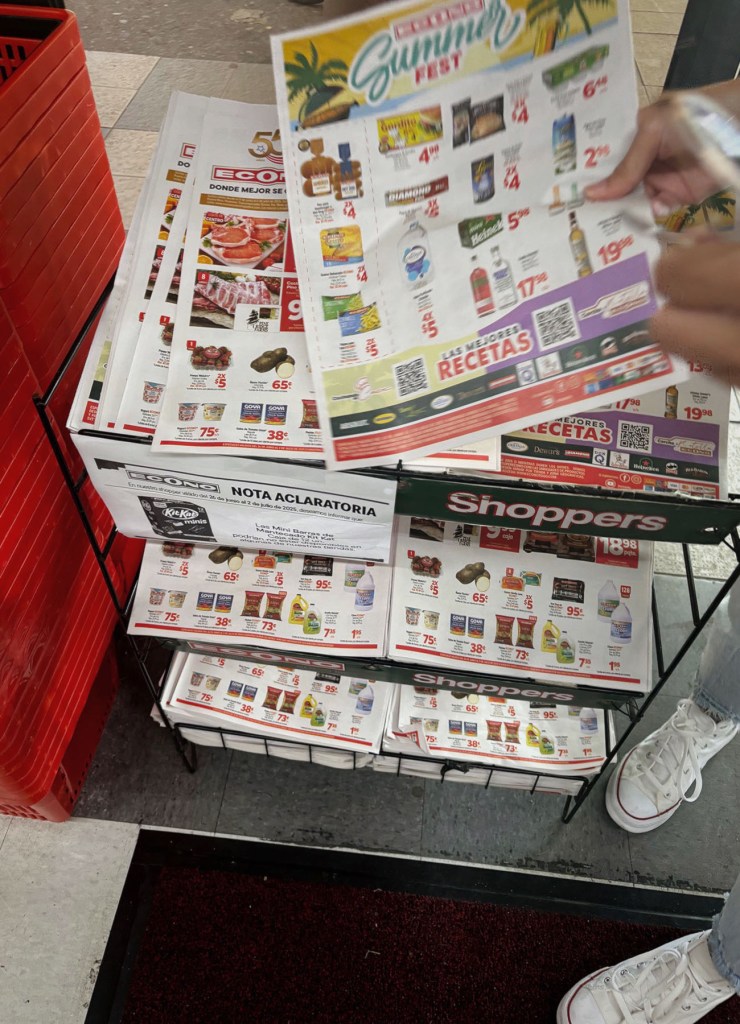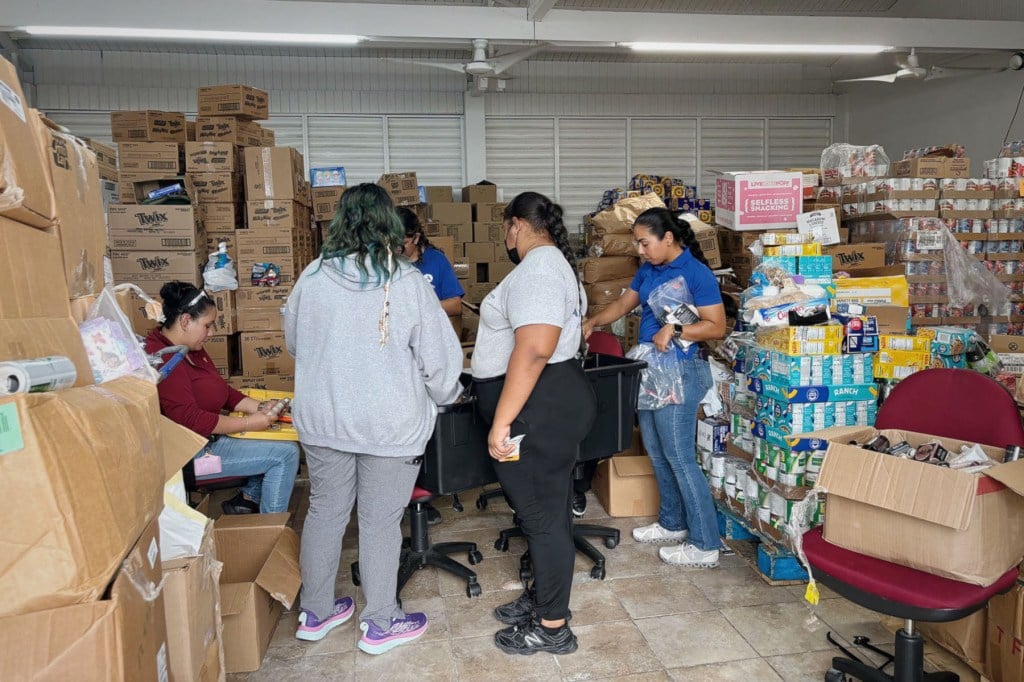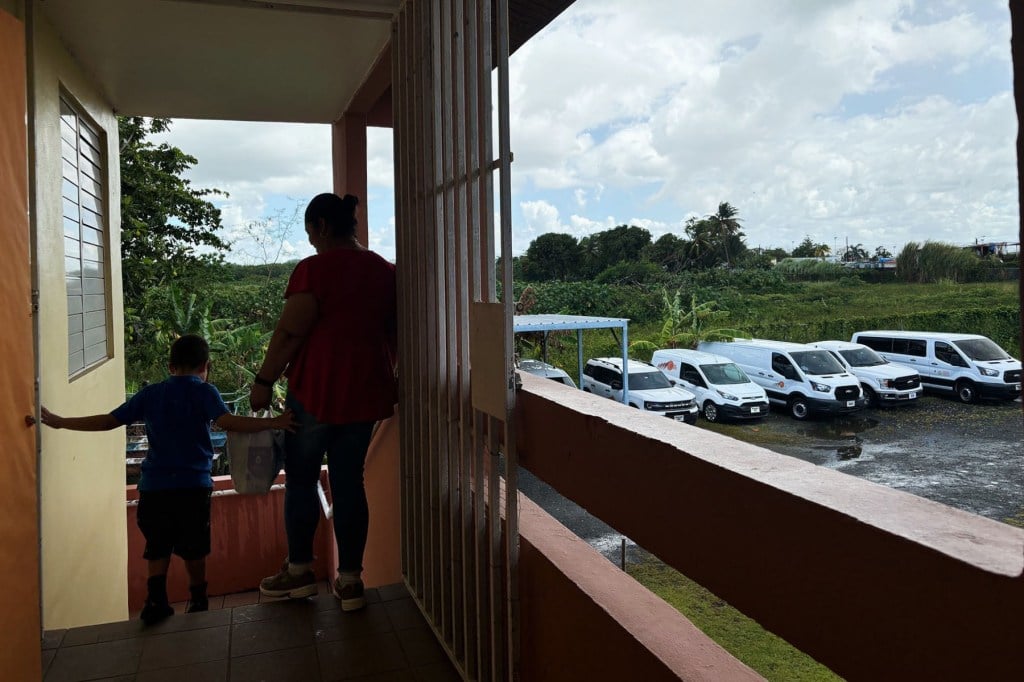SAN JUAN, Puerto Rico — Arriving two hours early to a morning food bank drive, only to be the 320th person in line. Anticipating food spoilage from apagones, the common energy blackouts that can sweep swaths of Puerto Rico at a moment’s notice. Scouring shoppers — deal pamphlets found at supermarket entrances — to maximize every penny of a tight budget in a territory where regular retail coupons often aren’t accepted.
Grocery shopping in Puerto Rico while on federal food assistance can look a lot different than in the United States: Aid funds go half as far in an ever-more-expensive food system still recovering from the devastation of Hurricane Maria eight years ago. And the major tax and spending package just passed by Congress freezes a mechanism used to raise federal food assistance funds.
Puerto Rico residents don’t have access to the Supplemental Nutrition Assistance Program, or SNAP; they operate on a more limited version known as the Nutrition Assistance Program (NAP) — one that now will struggle even more to serve those who need help feeding themselves and their families, the majority of whom are women.
“It’s not for buying ice cream or cakes. Meat is expensive, even the vegetables and the food the nutritionist wants us to eat,” said Diane Call Fragoso, a NAP recipient who lives in the San Juan-adjacent city of Carolina with her 40-year-old daughter, Terydian. “Those things cost — the cheapest are not the healthiest.”
Call Fragoso ran a boutique called Sexy Curves, catering to women in a higher size range until the owner closed the building nine years ago. She unexpectedly joined the nearly 5 percent of Puerto Ricans currently facing unemployment, one of the highest rates across the United States and its territories.
Call Fragoso and her daughter receive about $220 on the eighth of each month — the monthly average NAP benefit is $115 per person — a figure that has been relatively stagnant since she joined the program 9 years ago. In contrast, SNAP benefits for a family of two average $364 a month; in states where the costs are as high as those in Puerto Rico, they can go up to $536.

The assistance goes only about a third as far as it used to, Call Fragoso said, especially with inflation driving up prices in recent years.
“How can you buy food for a month with that kind of money?” Call Fragoso said. Before, she could fill a shopping cart with her NAP funds. Now, “if I’m going to buy the simple things that you’re supposed to buy, for that kind of money, I would get maybe three, four bags of groceries for both me and my daughter.”
Over 40 percent of the population lives below the poverty line in Puerto Rico, and even within that group, only about half are eligible for the NAP funding. The number of people getting NAP benefits has grown significantly over the last two decades — the population would be one of the biggest to receive SNAP benefits if Puerto Rico were a state — even as the archipelago lost hundreds of thousands of residents to migration. Almost 3 in 5 recipients are women; 1 in 4 are under 17 years old.
Unlike SNAP, which fluctuates based on need and population size, NAP is funded via a block grant, so it’s not responsive to natural disasters, food shortages or other local crises. Benefit schedules for both SNAP and NAP are calculated based on a number of factors, including the Thrifty Food Plan (TFP) — the baseline used to calculate the weekly cost of buying food to maintain a healthy diet. The last time there was an update to TFP in 2021, the calculation increased the NAP block grant by around 23 percent.
The massive tax and spending package passed this month by Congress didn’t cut into current NAP funding levels like it did SNAP. But it froze future increases via TFP, limiting the potential for billions of dollars to be poured into both of those programs over the next 10 years.
Puerto Ricans are used to a constant level of frustration with the federal government, residents and advocates told The 19th. As with other territories, political representation is limited: its resident commissioner is a non-voting House member elected by direct popular vote, and residents cannot vote for presidential candidates.
Ignangeli Salinas-Muñiz is a doctoral candidate who works with the Puerto Rican Opinion Lab out of the University of Michigan. People recognize that they have limited influence over the federal government, she said, but there’s been an increase in concern over the inequality in Puerto Rico-U.S. relations over the past few months. While President Donald Trump’s freezing of federal funding early this year didn’t stop the flow of SNAP or NAP dollars, the latter program was briefly under review for cuts, per a January memo — adding to a long-standing sense of precarity.
“It’s more complicated than this, but there is an awareness or a belief that the United States can do whatever it wants to Puerto Rico,” Salinas-Muñiz said of the residents she has spoken with. “They noted that they’ve never treated us equally, but now — and I’m extremely paraphrasing — we are in danger. More harm might fall upon them.”
Under a GOP-controlled White House and Congress, the approach to social safety net programs has been increasingly aggressive, exemplified by the recent budget reconciliation process that saw billions of dollars in cuts to programs including Medicaid and SNAP. This posture is concerning for future discussions about aid in Puerto Rico, said Javier Balmaceda, a researcher with the Center on Budget and Policy Priorities.
“Puerto Rico already suffers a huge inequity with respect to what states get in assistance,” Balmaceda said. “It feels like an open attack on these entitlement programs that provide a baseline for families that are already struggling so much.”
Over 1,500 miles away from Capitol Hill, residents face constantly rising prices, exacerbated by supply chain issues that also hit the United States earlier this year — and especially detrimental for a territory that imports over 80 percent of its food, particularly after Hurricane Maria damaged local agriculture.
Women who participate in NAP detailed to The 19th the deep level of precision and strategy they use to make their money go as far as it can: constantly scanning for deals, avoiding weekly shopping trips in favor of bulk runs, determining the week’s menu of food based on what free items they’re able to get before they spend a dollar of their funds.
The effects of rising prices are evident walking into budget supermarkets in the San Juan metropolitan area, from bustling Carolina to the university area Río Piedras. A 12-ounce can of corned beef is $6, a gallon of milk $7, a pack of string cheese $7.50. As in the continental United States, eggs are a pain point. A carton here could still run as high as $10 or $13, for example. Puerto Rico has a median household income of $25,000, half of the average earnings in the poorest state, Mississippi.

“Really, it almost never covers the whole month,” Katie Holguín, a mother who has been on the program for around seven years, said in Spanish. She receives about $350 for her household on the 12th of each month, but “more or less by the 25th or 30th, there’s nothing left. I have to go back to other sources to be able to get what I need until I get the benefits again.”
If she shows up to the store with $20 to spend, that sum gets wiped out immediately by just a carton of eggs or milk: “It doesn’t even cover making breakfast for the week,” Holguín said. Something like bacon is out of the question; even rice, a staple Puerto Rican ingredient, is incredibly expensive, she added.
And then there’s the apagones, blackouts caused by an aging electrical system and lasting hurricane damage that can affect parts of the archipelago for days or even weeks. A transmission line failure last summer knocked out power for weeks during a heat wave, while a New Year’s outage affected most of Puerto Rico this year. SNAP households can rely on deals for frozen and bulk groceries to make funds stretch. But many NAP users avoid buying cold items like frozen chicken or ice cream during hurricane season, just in case a blackout strikes. To waste dollars on items that could spoil at a moment’s notice would feel irresponsible, recipients told The 19th.
The apagones can affect everything, Holguín said. “It spoils the food you sacrificed so much to get, in case it gets ruined. The government can help you if your appliances get damaged, but they don’t give you anything for food.”
Government administration is another pain point in itself, program users said. NAP recipients described being caught between an oscillating set of obstacles, from a confusing digital landscape that makes it difficult to solve basic problems, to busy call centers. COVID-19 shut down or relocated physical offices too.
“Everything really got worse than the bad it already was, because during COVID, lots of systems failed, and people and systems didn’t come back the way they were before,” Holguín said.

Puerto Rico joining SNAP has been discussed in earnest for years, but this lack of infrastructure in particular has hurt its chances, even in the eyes of Congress members otherwise sympathetic to the block grant’s heavy limitations. Proponents argue that the transition — a switch that would cost up to $414 million, according to the last major feasibility study from 2022 — would dramatically improve the economy and the lives of many residents, even more than increasing the block grant itself.
But that goal is far off. Getting NAP to be somewhat commensurate with a hypothetical SNAP funding pool would require up to $2 billion more each year to address food needs. All of this is a no-go in a Congress that is both eager to cut federal spending and stalled on negotiating the farm bill, the United States’ main agricultural funding vehicle. Despite the Puerto Rican legislative assembly proposing resolutions to study the transition or allocate anticipatory funding, federal officials have repeated for years that the territory just isn’t ready.
“Of course we’re not ready. No one is ready to transition in a year. That’s not what we’re asking,” said Mari Jo Laborde, the director of the Banco de Alimentos De Puerto Rico, a food bank operating out of Carolina that distributed 21 million pounds of food last year.
“If you’re not even allowing us to explore the possibility, then you’re stepping on the possibility of Puerto Rico to grow, to get out of poverty,” she said. “If you don’t allow us to begin getting ready … it’s a self-fulfilling prophecy.”
The food bank also facilitates a “mochila alegre” program, which allows one child per household between ages 3 and 11 to select a set of shelf-stable products to take home ahead of each weekend. The Asociación Pro Juventud y Comunidad helps 50 families in Cataño and Toa Baja, located in the San Juan metropolitan area, feed their children over the weekend, when they don’t have access to free school meals.

Volunteers used to box up the food itself to give away, but two years ago, they turned a small room into a storefront to give kids more autonomy in choosing the food they ate over the weekends — mashed potatoes, canned carrots, salchichas and applesauce being among the most popular options. Despite being limited to one child per household, when workers know that there are multiple siblings, they’ll allow the recipient to take home a little extra when supplies allow.
Puerto Ricans are proud of their resilience in the face of colonization, leading to a fierce grip on maintaining culture and ownership over their homeland. But nearly everyone knows someone who has left in recent years in search of opportunities in the United States or beyond: family members, children, friends.
Call Fragoso, whose sisters joined their aunt in North Carolina after Hurricane Maria, said she’s going to stay. After all, she’s already paid off her house and has recently applied to a local loan program in hopes of restarting her business. She and other women said they want more investment in employment and economic opportunities from the government to be able to sustain themselves comfortably.
The message she wants from the government, she said, is this: “‘Let me invest to help you not depend on me. I will spend money now, but at the end, you will be successful without needing me.’”
Feeling overwhelmed by the news? The 19th is considering new ways to keep you informed. But we need your input. Fill out this quick survey to share your thoughts.





